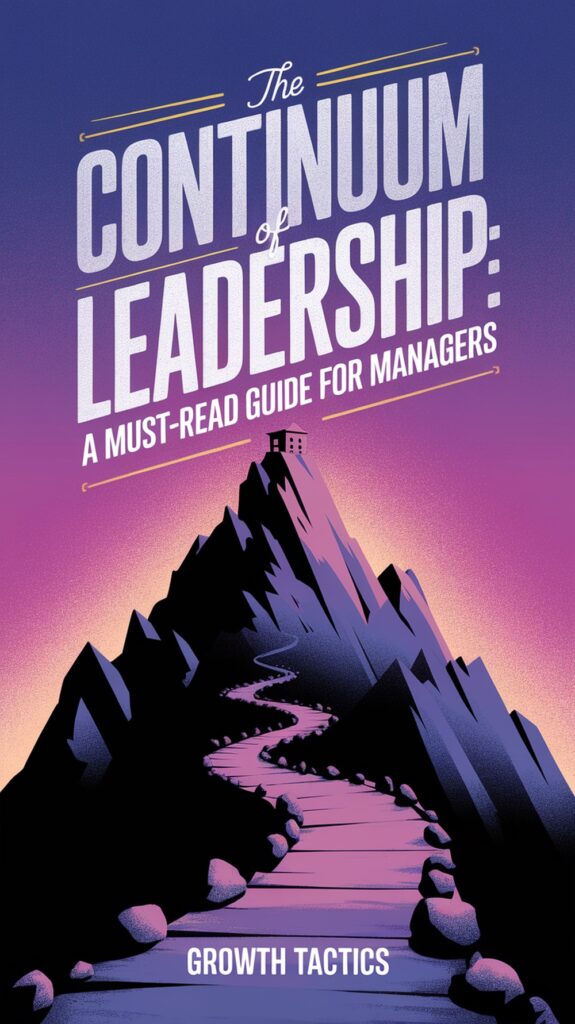The continuum of leadership refers to the various leadership approaches leaders may or should take when managing their teams. These leadership styles are adaptable to various situations, environments, and team capabilities.
Understanding where you, as a leader, fall on the continuum allows you to choose the best tactics for effective leadership. The following sections describe each aspect of the continuum in detail and how and when to use it.
Jump To Section
What Is the Leadership Behavior Continuum?

The leadership behavior continuum describes a range of practices for leaders to direct their teams. It ranges from authoritarian, command-and-control leadership all the way to highly adaptable, transparent, collaborative, team-led structures.
This concept was introduced in 1958 by Robert Tannenbaum and Warren Schmidt. They realized that effective leaders are not one-dimensional.
Styles go from one extreme to the other. On one side, you have “Tells,” where the leader dictates every decision, and on the other, “Team,” where the entire team works together and decides collectively.
The continuum helps leaders in business see why different situations need different kinds of leadership, not just one fixed approach.
Defining the Sliding Scale
The sliding scale represents the level of control a leader or team possesses. On one side, the leader does everything by themselves and just tells people what to do.
At the middle of the continuum, you have “Consulting,” where the leader seeks ideas and feedback while retaining the ultimate decision. At the other end, decisions are made by the collective and the leader retreats from the forefront.
That model’s flexibility allows leaders to calibrate their approach to meet what’s required. Here are some key traits on the scale:
- Authoritarian: The Leader makes all choices
- Selling: Leader explains reasons, seeks buy-in
- Suggesting: The Leader asks for ideas, picks the best
- Consulting: Leader seeks feedback, decides
- Joint: The Leader and the team decide together
- Delegating: The Leader hands off tasks
- Team: Team leads all decisions
This continuum is an illustration of how true leadership usually exists between extremes, combining traditional and modern approaches.
Why This Model Still Matters
Although this concept was introduced over 6 decades ago, the continuum is still a good fit for today’s work environment. It helps leaders at all levels learn which style fits best, so they can handle change and different team needs.
It’s not unusual for leaders to begin in the “telling” mode, eventually transitioning to “consulting” or “delegating” as their organization expands.
Exploring the Leadership Spectrum Stages

The Tannenbaum and Schmidt Leadership Continuum explains a range of approaches to management. This continuum describes the different stages of leadership that leaders at the managerial level can embrace. As you can see, each stage indicates an increasingly higher level of leader ownership and team engagement.
In this section, we take a closer look at each stage, utilizing real-world examples. But first let’s take a look at a table illustrating the characteristics of each stage.
| Stage | Who Decides? | Team Involvement | Key Strength | Main Challenge |
|---|---|---|---|---|
| Telling | Leader | None | Speed, clarity | Low morale, disengagement |
| Selling | Leader | Low | Persuasion, clarity | Pushback, skepticism |
| Suggesting | Leader | Moderate | Input, creativity | Lacks final clarity |
| Consulting | Leader | High | Buy-in, better decisions | Time, complexity |
| Joining | Shared | High | Ownership, engagement | Confusion of roles |
| Delegating | Team | Very High | Autonomy, growth | Risk of errors |
| Abdicating | Team | Full | Innovation, trust | Lack of direction |
Understanding these stages is critical for smart leadership development. You will find that leaders who use the full spectrum of their style create more adaptive teams and longer lasting success. Awareness of organizational culture and personal bias helps prevent missteps, such as using a controlling style when empowerment is needed.
1. Telling: Leader Makes Decisions
The first stage, “telling,” is at the autocratic end of the spectrum. In this stage, the leader doesn’t consult the team and makes decisions by themselves, dictating them to the group. This approach works best in crisis situations where time is of the essence.
It’s equally effective for day-to-day operations where discussion isn’t necessary. For instance, a hospital emergency room chief might have to make rapid assignment decisions in a disaster. The positive side to this style is that it is fast. Members are clear on expectations, and progress can begin immediately.
This kind of top-down action can be demoralizing, particularly to highly technical teams that desire an outlet for their ideas. If overused, it can lead employees to feel ignored or de-prioritized.
2. Selling: Leader Persuades Team
Although the leader chooses in this stage, they seek to align their team behind their decision. Above all, clear, honest communication goes a long way. Leaders tell people why things are happening and try to get buy-in instead of mere compliance.
This approach is effective when the change is large but not time-sensitive, like a business implementing a new software system. The leader should be assertive and confident, while still open to listening and addressing valid concerns. Effective selling focuses on building trust and overcoming skepticism.
This method of active, participatory engagement not only strengthens buy-in, but it also diminishes pushback and eases changes through the pipeline.
3. Suggesting: Leader Presents Ideas
The “suggesting” stage is where things start to get more collaborative. Unlike the last stage, the leader presents ideas but allows for feedback and discussion. Now team members can weigh in, offer feedback, or suggest tweaks before any choice is finalized.
This suggesting stage sets the tone for collaboration. It is especially effective in creative fields.
The leader guides the discussion while allowing room for team members to share. By allowing free-ranging ideas, leaders can foster creativity and ensure that participants feel listened to.
4. Consulting: Leader Gets Input
In the fourth stage, a consulting leader gets input from the team and solicits their ideas before deciding. Effective leaders who consult well signal that they are open to input by asking, listening, and reflecting back what they’ve heard.
Consulting increases engagement. Because team members feel valued, they tend to go the extra mile for the resulting decision.
It helps with making better decisions as well, because more perspectives are taken into account. Skills such as active listening and empathy are incredibly important in this phase. It’s a slower process and not well suited for situations requiring immediate action.
5. Joining: Leader Defines Limits
During the “joining” stage, the leader partners with the team to determine boundaries and guidelines for decision-making. Within these boundaries, the community can debate openly and collaboratively to determine shared priorities.
This approach is one of mindfulness and equilibrium. Leaders provide the framework but allow the team to determine how to accomplish what is needed.
For instance, a “joining” manager may define sales targets but allow the team to choose their own approach to achieve them. This method cultivates a greater sense of ownership and usually increases commitment as well.
6. Delegating: Team Has Freedom
Delegation is when the leader pulls back, leaving the decision-making authority with the team. The leader gives the group the freedom to make decisions autonomously and intervenes only when necessary. This stage is most effective with experienced, confident teams that understand the objectives and expectations.
Delegating can be a powerful source of motivation and growth. Team members typically value the freedom and trust they’re given, and they usually raise the performance bar themselves. It’s most applicable in knowledge and creative worker roles, such as design or engineering teams.
Yet delegation is not without its dangers. Without oversight, it’s very easy for less experienced employees to make missteps.
7. Abdicating: Team Leads Itself
Abdicating is the last stage on the Leadership Spectrum. The leader abdicates and lets the team self-govern. This is the rarest stage, containing the most mature, skilled teams. Imagine the self-organizing project teams of technology innovators or creative design firms.
Abdication grants autonomy in its entirety. When given autonomy, teams create their own structure, pace, guidelines, and end goals. It can result in total anarchy if you don’t provide your team with any structure or consequences.
There are plenty of successful examples, but only when teams are well-prepared and when everyone on the team shares a sense of purpose.
Forces Shaping Your Leadership Style

Alright, so we’ve established that leadership style is on a continuum, influenced by a range of internal and external factors. A leader’s style is not simply a personal preference.
It’s an artful blend of inner conviction, organizational culture, and the demands of your project and time. This is where self-awareness becomes very important. In this section, we’ll go into more detail on the factors affecting your leadership style.
Key factors shaping leadership style include:
- Situational demands and workplace pressures
- Awareness of bias (personal and organizational)
- Team needs, skills, and motivation
- Organizational culture and industry norms
- Societal expectations
- Past experiences as both a leader and a team member
Understanding Situational Demands
Understanding situational demands is crucial. Situational pressures frequently shape leaders’ decisions as to which style is most appropriate. Their Leadership Continuum shows that leadership style is not static.
It can go from autocratic to democratic, depending on what’s called for. Conversely, during a crisis, a more authoritarian approach might be more effective. Day-to-day, more egalitarian, transparent, and open styles allow teams to thrive and grow.
Leaders who regularly assess the current situation, like changes in objectives, timelines, or the abilities of team members, are more likely to adjust accordingly. Continued flexibility is important, as team needs and external expectations seem to constantly change.
Responding to Team Member Needs
Team members want to feel understood by their leaders. Responding to team member needs is crucial, as your needs change, so will the needs of your team. Leaders must regularly take the pulse via feedback, one-on-ones, and most importantly, listening.
Empathy, trust, and good judgment go a long way to ensuring that leaders know when to step in and when to let things go. The ultimate goal is to try to get to at least the delegating side of the spectrum, but that may not always be what the team needs.
Organizational Culture and Industry Norms
The culture of a company and the standards of its industry play a huge role in shaping how leaders act and make decisions. For instance, in the tech industry, leaders often focus on executing ideas quickly and thinking creatively to innovate. On the other hand, in the healthcare sector, there’s usually a strong emphasis on following strict rules and procedures due to the need for safety and reliability.
By recognizing these differences, leaders can better tailor their actions and strategies to fit their organization’s unique environment and the broader industry context, leading to more effective decision-making and improved outcomes.
Apply the Continuum Effectively

Applying the continuum of leadership takes more than just knowing the model. It requires a call to action within an office or organization. Applying it effectively will require leaders to be open-minded, humble, and exercise sound judgment.
Trust is essential. Leaders must have the confidence to admit that at times a specialist is more qualified, and senior staff should not have to dictate every decision. Let’s look at some steps you can start to utilize the knowledge you’ve gained in this article.
Assess Your Current Situation
Start with a deep look at your workplace. Check team skills, moods, and outside factors that might shape choices. Tools like surveys, feedback forms, or quick stand-up meetings help you get a good pulse of your team.
Choose the Right Approach
Choose the appropriate approach to the data. For example, during a major crisis, maybe an action-oriented, no-nonsense style is most appropriate. In more peaceful times, communicating decisions helps establish trust.
Align your approach with your team’s strengths and your organization’s vision. Look for indicators that your approach is working, such as strong support from your team. Also, look for signs your approach is not working, such as a decline in morale.
Communicate Your Chosen Style
Don’t be afraid to communicate your style to the team. Communicate your chosen style clearly.
Communicate what’s required and how decisions are made. Ensure all stakeholders understand why you have chosen this style and what role they have. Continued communication is key to keeping everyone on the same page and coordinated.
Adapt as Conditions Change
Adapt as conditions change. Test repeatedly to see what’s effective. Watch for signs and failed benchmarks, like heavy strain on your staff or changes in the external environment.
In order to maintain a productive atmosphere, be ready to adapt your approach. An openness to adapt allows teams to learn and improves the quality of outcomes over time.
- Use regular check-ins and feedback loops.
- Hold short training sessions on different leadership styles.
- Ask for team input when shifting approaches.
- Share wins and lessons learned with the group.
- Stay honest about what’s working and what’s not.
Benefits of Flexible Leadership Using the Leadership Continuum

This approach isn’t just theory. It allows leaders to be responsive to the needs of their team, the demands of the work, and the larger vision. Below are some of the benefits you can expect from being a flexible leader.
Boost Team Engagement
When leaders stretch their style, team engagement can increase immediately. A flexible leader seeks input and feedback from their team and listens to their thoughts to allow them to inform decisions. This fosters buy-in and helps ensure that people stay engaged.
There’s a tangible connection between leaders’ behavior and their employees’ sense of fulfillment at work. For instance, a manager who allows employees to lead meetings or experiment with new responsibilities builds their sense of empowerment.
Here are a few quick wins:
- Give team members a say in project planning.
- Rotate who leads weekly check-ins.
- Schedule brief one-on-one meetings to listen to objections.
- Celebrate small successes out loud.
Develop Future Leaders
When flexible leadership makes space for this next generation of leaders, everyone wins. When team members have the opportunity to make decisions or guide mini-projects, they are beginning to develop their own leadership abilities. This expands their confidence and advances the entire cohort.
Mentorship is incredibly important. For example, a manager may decide to have a less experienced employee partner with a more experienced one to collaborate on a project. In the long run, this creates a talent pipeline. Making these kinds of investments in people not only helps the current team avoid turnover but creates a more well-rounded team prepared for future roles and transitions.
Improve Decision-Making
When leaders employ the continuum model, they achieve superior decision-making. By pulling from both styles, at times leading and at other times receding back, they’re able to access a broader range of ideas.
This combination allows teams to engage and address issues as they emerge, allowing them to remain quick and adapt to changing conditions.
Potential Downsides and Considerations

The continuum of leadership can have some drawbacks. Let’s talk about how we can avoid these.
Risk of Inconsistency Confusion
Changing up styles can really throw employees for a loop if not executed properly. When leaders switch between a hands-on and a hands-off approach, the team members are left confused about what they can expect.
Imagine your boss puts you in charge of a project, but as soon as the first thing goes wrong, he steps in and takes over. He doesn’t really tell you why, just that he’s taking the lead. This would likely make you think he doesn’t believe in you.
Having well-defined parameters and establishing open lines of communication ensures that all partners are on the same page and working toward the same goals.
Consistent, frequent communication and honest conversations reaffirm the standards’ purpose and what’s expected.
Using our previous example, imagine the boss saying I know I gave you the lead on this project, but the deadline just got moved up 2 weeks, so I will be working with you to ensure we get this project completed on time. You would probably feel a little bit better having all the information.
Requires High Leader Self-Awareness
Strong self-awareness is key to effective leadership. Leaders need to be aware of their strengths, limitations, and biases, both personally and organizationally.
Tools, such as feedback surveys or honest self-reflection, can assist leaders in developing the skills to identify blind spots.
High emotional intelligence is pivotal, allowing leaders to feel the room and understand when to pivot.
Matching Style Takes Practice
We are all biased towards leading a certain way and it can be hard to switch your style. For example, you may be really good at micromanaging but you have a very experienced team that needs a more hands-off approach.
In this case, when you try to be hands-off, it can feel like you’re not doing anything, but you need to be more hands-off to bring out the best in your team. Sometimes it can be hard to do what’s best for the team, but practice makes perfect.
Conclusion
To be effective in leadership, people need to know where they fall on the leadership continuum. They need to know what helps or hurts their approach. A leader who learns to bend and try new ways can help teams do better and keep things running smoothly.
Ultimately, the most effective leaders are those who are willing to go beyond the surface and be flexible in their approach.








